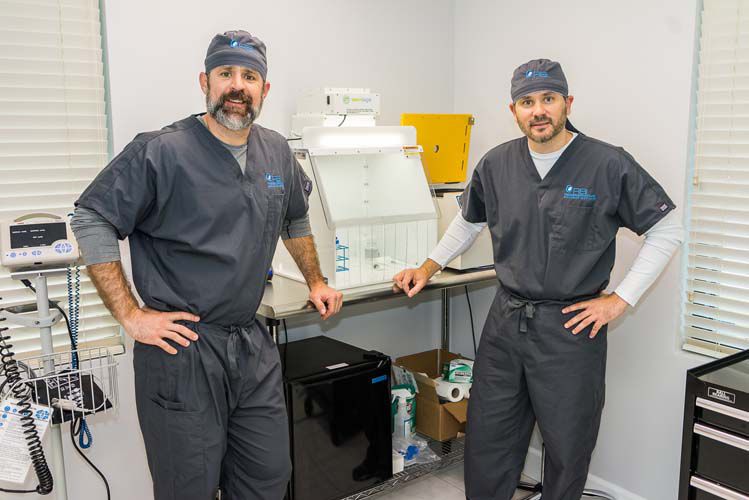
Pain is big business, and treating arthritis pain is one of the biggest parts of that business.
Arthritis ranks as the third most common cause of pain in the U.S. behind only chronic back problems and headaches.
More than a quarter of the U.S. population “has been told by a doctor that they have some form of arthritis,” according to the Centers for Disease Control, and “the most common form of arthritis is osteoarthritis.”
In an effort to combat arthritic pain, some 300 million prescriptions – worth about $24 billion – are written each year.
Here in Vero Beach, however, Jason Griffeth, managing director at the Regenerative Biologics Institute, and RBI’s medical director Dr. Brett Haake, are taking a decidedly different approach to treating osteoarthritis pain.
“Osteoarthritis,” according to WebMD, “is commonly known as wear-and-tear arthritis. It is a condition in which the natural cushioning between joints – cartilage – wears away. When this happens the bones of the joints rub more closely against one another with less of the shock-absorbing benefits of cartilage. The rubbing results in pain, swelling, stiffness, decreased ability to move and, sometimes, the formation of bone spurs.”
Griffeth and Haake are seeking to combat that pain, swelling and stiffness by restoring worn-out or lost cartilage using stem cell and platelet-rich plasma injections.
“We specialize in regenerative medicine,” says Griffeth. “Essentially what that is, is trying to replace damaged or diseased tissue with new healthy and functional tissue. We do that by isolating the body’s own healing ability, concentrating it and putting it into the area of need.
“The way that the body heals itself is with stem cells and with platelets. So we will take a tissue sample from the patient: Usually an adipose or fat tissue sample, because it tends to be the richest source.
“Then,” Griffeth continues, “we isolate the regenerative cells and concentrate them and then we combine that with highly concentrated platelets and inject that directly [back into the patient]. It mimics the body’s natural healing mechanisms and it’s just a better therapy.”
The therapy, while promising, is not yet fully recognized.
The American Academy of Orthopedic Surgeons reports that “treatment with stem cells and platelet-rich plasma could hold promise; however, current research studies to back up the claims in the media are lacking.”
In 2015, the National Institutes of Health chimed in, saying more clinical trials needed.
Despite the call for more studies, Haake – who used a U.S. Navy scholarship to attend medical school, interned at the Naval Medical Center in Portsmouth, served his residency in anesthesiology and saw time in Afghanistan before coming to Vero – has no qualms about employing stem cell and platelet treatments.
“One of the more prominent studies that just came out,” Haake says, “was a retrospective study that looked at 1,128 patients, and what they found was that at least 90 percent of the patients had at least a 50 percent reduction in pain.” Moreover, says Haake, “with those 1,128 patients, there were zero measured adverse events.”
This backed up by the National Institutes of Health, which says “there are no reasonable arguments against treatment with the patient’s stem cells.”
“We have a guy that we’re talking to right now,” Haake continues. “His orthopedic surgeon is telling him, ‘I’m looking at your scan. You don’t need a knee replacement.’ And he’s like, ‘Well, I’m in excruciating pain. I’m a very active guy and the steroid injections aren’t working.’
“So that’s a perfect patient for us, because the orthopedic surgeon is saying, ‘Well, try this,’ but if someone needs a knee replacement and a surgeon has told them they need a knee replacement, I will never tell them, don’t get the knee replacement.”
One potential drawback to the treatment is cost, however. According to NIH, “at approximately $5,000 to $5,500 per knee for a stem cell injection – which will not be covered by health insurance or Medicare – this treatment is not affordable for everyone. Furthermore, it is likely that more than one treatment session would be required, meaning an even greater investment of time and money.”
So, simply put, stem cell and platelet-rich plasma injections are another option to consider for the millions of Americans currently suffering from debilitating arthritic diseases. While there are no guarantees and the treatment is costly, it may help ease or even eliminate arthritic pain.
The Regenerative Biologics Institute is at 3755 7th Terrace, Suite 102 in Vero Beach. The phone number is 772-492-6973.



